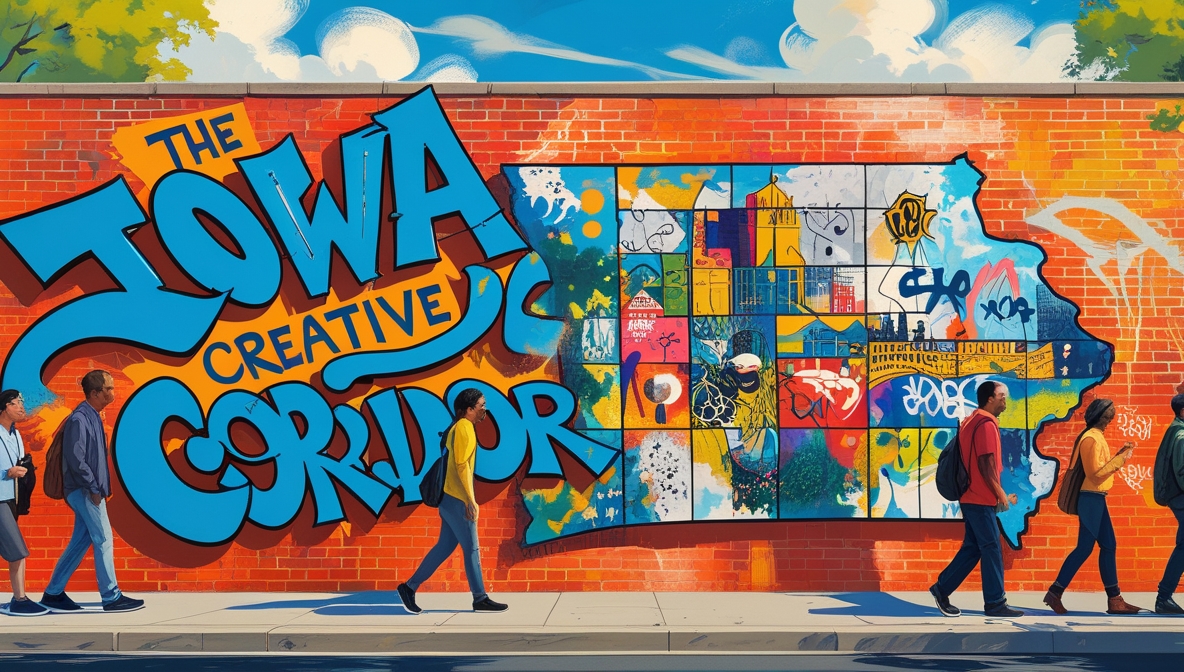Street art was once seen as an act of rebellion. It lived in the quiet corners of cities, tucked away in alleys, only visible to those who knew where to look. That changed when public walls became an open invitation instead of a warning. Iowa’s Creative Corridor embraced the shift, transforming neglected spaces into living, breathing stories.
Street art in this region isn’t just about color and creativity. It’s about community. It speaks to the past, reflects the present, and shapes the future. This isn’t a trend. It’s a conversation that has been growing louder with every painted brick.
The Early Days: A Struggle for Acceptance
Before murals brightened cityscapes, street artists had to fight for space. They worked under the cover of night, risking citations for expressing themselves. The term “graffiti” carried a negative weight, often dismissed as vandalism.
The Line Between Art and Graffiti
- Public perception shaped how street art developed. Early works weren’t welcomed; they were erased.
- Cities spent resources scrubbing walls instead of recognizing their artistic value.
- Artists relied on secrecy, with many leaving their mark anonymously to avoid fines.
As time passed, the value of street art became harder to ignore. What was once considered an eyesore turned into a defining feature of urban culture.
The Shift: From Hidden Murals to Celebrated Art
A turning point came when communities started to see street art as a cultural asset instead of a problem. Public art projects received funding. City officials and business owners collaborated with artists instead of calling for their removal.
The Role of Local Organizations
- Arts organizations played a key role in legitimizing the movement. They connected artists with city planners, creating official mural projects.
- Universities and galleries started featuring street artists, bridging the gap between fine art and public spaces.
- Festivals invited painters from across the country, bringing fresh perspectives to Iowa’s walls.
The Creative Corridor became a hub where art wasn’t confined to museums. It lived on the streets, making culture accessible to everyone.
The Stories Behind the Walls
Every mural tells a story. Some reflect local history, honoring figures who shaped the region. Others amplify voices that might have been overlooked.
A Tribute to Local Culture
- Murals highlight the region’s industrial roots, agricultural heritage, and growing tech scene.
- Indigenous artists use walls to reclaim narratives, sharing stories of resilience and identity.
- Collaborative pieces bring together multiple artists, blending styles to create something entirely new.
The walls of Iowa’s Creative Corridor speak loudly, but you have to slow down to listen.
The Artists Leading the Way
Behind every mural is an artist with a vision. Some grew up in Iowa, while others arrived to leave their mark. Their styles vary, but they all share a commitment to transforming public spaces.
Pioneers and Innovators
- Local artists broke barriers by painting legally sanctioned works that challenged assumptions about street art.
- Visiting muralists brought new techniques, blending traditional graffiti with contemporary design.
- Digital tools allowed artists to sketch concepts before a single spray can touched the wall.
The mix of old and new techniques makes the street art scene in Iowa unlike any other.
The Impact on Local Communities
Public art isn’t just for artists—it changes the entire community. Once-empty walls turn into conversation starters. Forgotten areas become destinations.
A Catalyst for Change
- Businesses thrive in areas with vibrant murals, drawing foot traffic that supports local economies.
- Schools partner with artists, using murals as educational tools to teach history, social justice, and creative expression.
- Public spaces feel safer and more welcoming, reducing the stigma around certain neighborhoods.
Street art has proven it can be a force for renewal, not just decoration.
The Challenges of Street Art in Iowa
Despite progress, challenges remain. Not every city in the Creative Corridor fully embraces public art, and some projects still face opposition.
Balancing Creativity with Regulations
- Some ordinances still restrict public murals, requiring extensive approval processes.
- Funding remains a challenge, with artists often relying on grants or personal investment.
- Weather conditions make mural preservation difficult, requiring constant maintenance.
Artists continue to push forward, finding creative ways to work within—and sometimes outside—these constraints.
What’s Next for Street Art in Iowa’s Creative Corridor?
The movement shows no signs of slowing down. More walls are being offered to artists, and public engagement continues to grow.
The Future of Public Art
- Augmented reality is being integrated into murals, allowing passersby to interact with the artwork through their phones.
- More businesses are commissioning murals to tell their brand stories, supporting local artists in the process.
- Youth programs are emerging to teach the next generation about the power of public art.
Street art has already reshaped Iowa’s Creative Corridor. What happens next is up to the artists, the community, and the city itself.
Final Thoughts
Street art started as an act of defiance, but in Iowa’s Creative Corridor, it has become something much bigger. It’s a celebration of culture, a tool for connection, and a reflection of the region’s evolving identity.
The walls of the Corridor aren’t just painted. They’re alive. And they’re still telling stories.
